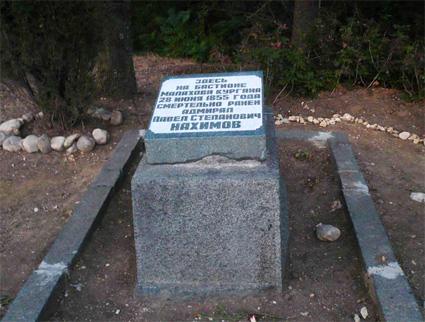|
Nakhimov Pavel Stepanovich
(23.06(06.07).1802-30.06(13.07).1855)
 An
outstanding Russian naval commander. An
outstanding Russian naval commander.
Born in the village of Gorodok, Vyazemsky district, Smolensk
province. After graduating from the Naval Cadet Corps in St.
Petersburg in 1818, he served in the Baltic Fleet. In the years
1822-1825. He circumnavigated the watch officer on the frigate
"Cruiser".
In 1827 he participated in the Navarino naval battle, commanding a
battery on the battleship Azov. In this battle, along with
Lieutenant P.S. Nakhimov skillfully and courageously acted future
naval commanders midshipman V.A. Kornilov and midshipman V.I.
Istomin. The defeat of the Turkish fleet in the Navarino naval
battle significantly weakened the naval forces of Turkey,
contributed to the national liberation struggle of the Greek people,
the victory of Russia in the Russian-Turkish war of 1828-1829.
During this war, Nakhimov then commanded the Navarin corvette,
participated in the blockade of the Dardanelles.
In 1829, after returning to Kronstadt, Nakhimov headed the frigate
"Pallada". In 1834, he was again transferred to the Black Sea Fleet and
was appointed commander of the battleship Silistria, which was
recognized as the best ship of the Black Sea Fleet in organizing
service, combat training and maneuvering at its beginning. Fleet
Commander Admiral M.P. Lazarev often held his flag on
"Silistria",
setting the ship as an example to the entire fleet.
Subsequently, Nakhimov commanded a brigade (since 1845), a division
(since 1852), a squadron of ships (since 1854), which served on the
coast of the Caucasus, suppressing attempts by the Turks and the
British standing behind them to undermine Russia's positions in the
Caucasus and The Black Sea.
With special strength, the military talent and naval art of Nakhimov
manifested themselves in the Crimean War of 1853-1856. Commanding a
squadron of the Black Sea Fleet, Nakhimov discovered and blocked the
main forces of the Turkish fleet in Sinop, and on December 1
(November 18), 1853, defeated them in the Sinop Sea Battle.
During the Sevastopol defense of 1854-1855 Nakhimov correctly
assessed the strategic importance of Sevastopol and used all the
forces and means at his disposal to strengthen the defense of the
city. Occupying the post of commander of a squadron, and since
February 1855, the commander of the Sevastopol port and military
governor, Nakhimov from the very beginning of the defense of
Sevastopol led the heroic garrison of the defenders of the fortress,
showed outstanding abilities in organizing the defense of the main
base of the Black Sea Fleet from the sea and from land.
Under the leadership of Nakhimov, several wooden sailing ships were
flooded at the entrance to the bay, which blocked access to the
enemy fleet. This greatly strengthened the defense of the city from
the sea. Nakhimov led the construction of defensive structures and
the installation of additional coastal batteries, which were the
backbone of the land defense, the creation and preparation of
reserves. He directly and skillfully carried out command and control
during the hostilities. The defense of Sevastopol under the
leadership of Nakhimov was highly active. Sacks of detachments of
soldiers and sailors, counter-battery and mine fighting were widely
used. Targeted fire from coastal batteries and ships delivered
sensitive blows to the enemy. Under the leadership of Nakhimov,
Russian sailors and soldiers turned the previously poorly protected
city from land into a formidable fortress, which successfully
defended for 11 months, repelling several enemy assaults.
|

Monument at the site of the wound P.S.
Nakhimov on the Malakhov Hill |
Nakhimov
enjoyed great authority and love of the defenders of Sevastopol, he
showed composure and restraint in the most difficult conditions, set
an example of courage and fearlessness to others. A personal example
of the admiral inspired all Sevastopol residents to heroic deeds in
the fight against the enemy. At critical moments, he appeared in the
most dangerous places of defense, directly led the battle. During
one of the detours of the front line fortifications of 1855,
Nakhimov was mortally wounded by a bullet in the head on the
Malakhov Kurgan. He was buried in the Vladimir Cathedral of
Sevastopol next to admirals M.P. Lazarev, V.A. Kornilov and Rear
Admiral V.I. Istomin. During the Anglo-French occupation of
Sevastopol, the graves were opened, the lids of the coffins were
broken, gold epaulettes from the uniforms were stolen
(One
can imagine what the newly-made Bandera critters would do with these
graves).
Merits of Nakhimov are marked by many Russian and foreign orders.
By a decree of the Presidium of the Supreme Soviet of the USSR of
March 3, 1944, the Nakhimov Order of the 1st and 2nd degree and the
Nakhimov Medal were established. Nakhimov naval schools were
created. The name of Nakhimov was assigned to one of the cruisers of
the Soviet Navy. In the city of Russian glory, a monument was
erected to Sevastopol Nakhimov in 1959.
Islands in the Nikolsky Shar Strait
in the south of the southern island of Novaya Zemlya. He named P.K.
in 1833 Pakhtusov |

